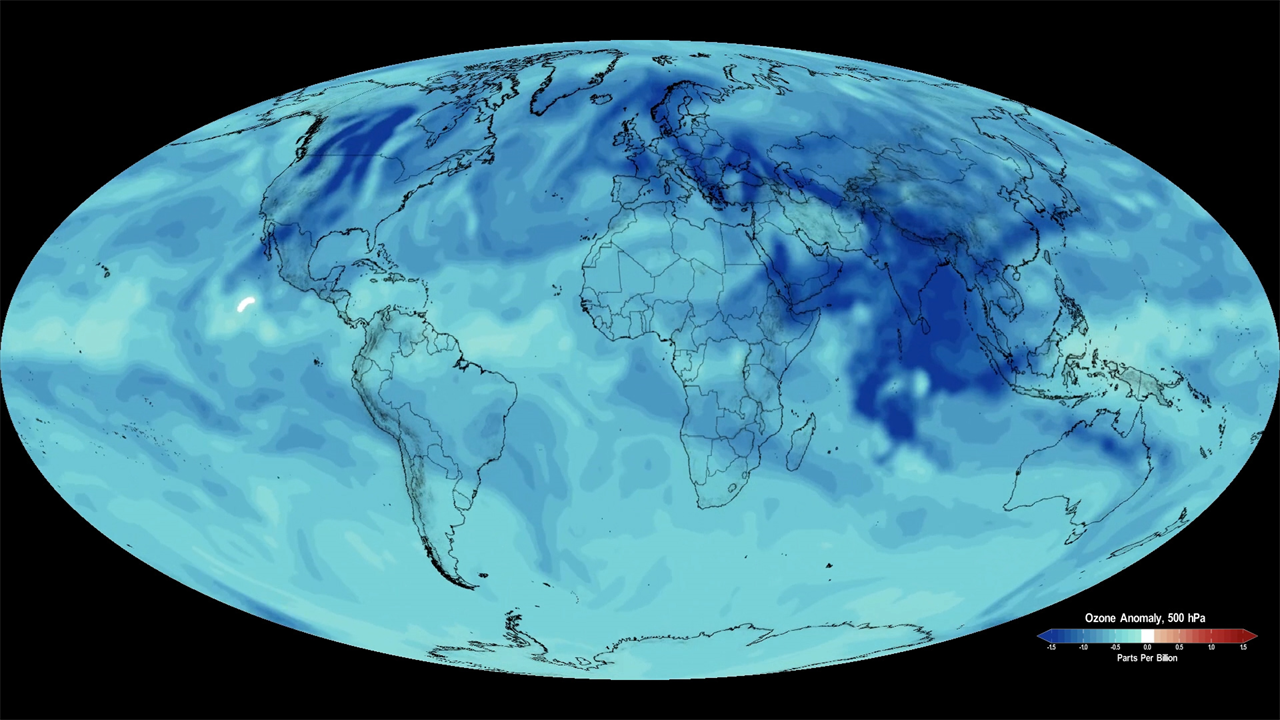NASA Finds Local COVID-19 Lockdowns Brought Unexpectedly Fast Global Ozone Reductions
0 View
Share this Video
- Publish Date:
- 16 June, 2021
- Category:
- Covid
- Video License
- Standard License
- Imported From:
- Youtube
Tags

A new study finds that reduced fossil fuel combustion due to lockdowns in US and Asian cities caused a global decline in ozone pollution. Credit: Pond5
When lockdowns during the coronavirus pandemic reduced local nitrogen oxide emissions, the effect on ozone pollution was global and unexpectedly rapid.
As the coronavirus pandemic slowed global trade in early 2020, emissions of nitrogen oxides (NOx) — which cause ozone, a threat to human health and the climate — fell by 15% globally, with local reductions of up to 50%, according to in a study led by scientists at NASA’s Jet Propulsion Laboratory in Southern California. As a result of lower NOx emissions, ozone levels worldwide had fallen by June 2020 to levels that policymakers believed would take at least 15 years by conventional means, such as regulation.
The study shows that innovative technologies and other solutions aimed at reducing NOx locally have the potential to rapidly improve air quality and climate worldwide. It was published in Science Advances on June 9, 2021.
As the coronavirus pandemic slowed global trade in early 2020, emissions of nitrogen oxides (NOx) — which cause ozone, a threat to human health and the climate — fell by 15% globally, with local reductions of up to 50%, according to a study led by scientists at NASA’s Jet Propulsion Laboratory. Credit: NASA’s Goddard Space Flight Center/Scientific Visualization Studio
Ozone protects us from destructive solar radiation when it is high above the Earth in the stratosphere. Closer to the ground, however, it has other lasting effects. Surface ozone caused an estimated 365,000 deaths worldwide in 2019 from damage to the lungs of vulnerable people, such as young children and people with asthma. Likewise, it damages plants’ respiratory systems — their ability to photosynthesize — reducing plant growth and crop yields. And at the top of the troposphere, it’s a potent greenhouse gas that raises global temperatures.
When the world went into lockdown, scientists had an unprecedented opportunity to study how human activity interacts with natural Earth system processes on a regional and global scale. A team of international researchers led by JPL scientist Kazuyuki Miyazaki took this opportunity to investigate the two main nitrogen oxides: nitrogen oxide and nitrogen dioxide, collectively called NOx. They mapped the chain of events from reduced fossil fuel combustion during lockdowns to reduced local NOx emissions and ultimately to reduced global tropospheric ozone pollution. The stricter the lockdown a country imposes, the greater the reduction in emissions. For example, in early February 2020, China’s home orders reduced NOx emissions by 50% in some cities within weeks; most US states hit a 25% drop later in the spring.
The overall result of the reduced NOx emissions was a 2% drop in the global ozone layer – half the amount the most aggressive NOx emissions controls required by the Intergovernmental Panel on Climate Change, the authoritative body of international experts on climate change. climate, were expected to produce over a 30-year period.
Ozone reductions from the reduced NOx emissions quickly spread around the world and from the surface more than 10 kilometers upwards. “I was really surprised at how big the impact on global ozone was,” said JPL scientist Jessica Neu, a co-author of the new study. “On the surface, we expected more of a local response.”
The reactions that convert NOx to ozone require sunlight and depend on many other factors, such as the weather and what other chemicals are in the air. These factors interact in so many ways that, in some circumstances, reducing NOx emissions actually increases ozone. So researchers cannot understand or predict ozone concentrations based on NOx emissions data alone. That calls for a more in-depth analysis, such as this study.
The researchers used measurements of NOx, ozone and other atmospheric gases from five NASA and ESA (European Space Agency) Earth observation satellites. They ran the multiple satellite observations in four numerical models of atmospheric chemical reactions and weather, using a data analysis system developed by JPL. They found that the models’ atmospheric changes matched well with the satellite observations, and that they reproduced known increases and decreases in emissions as regions went in and out of lockdown. These findings indicate that both NOx emissions and global ozone will rise again as the global economy picks up.
“I was very pleased that our analysis system was able to capture the detailed changes in emissions around the world,” said Miyazaki. “The challenging and unprecedented nature of this work is evidence of improvements in satellite monitoring serving societal needs.” This new ability to combine multiple types of satellite observations and models is already unlocking a new understanding of Earth’s atmosphere and how it is changing.
Reference: “Global tropospheric ozone responses to reduced NOx emissions linked to the global lockdowns of COVID-19” by Kazuyuki Miyazaki, Kevin Bowman, Takashi Sekiya, Masayuki Takigawa, Jessica L. Neu, Kengo Sudo, Greg Osterman and Henk Eskes, June 9 2021 , Science Progress.
DOI: 10.1126 / sciaadv.abf7460
The research team also included scientists from the Japan Agency for Marine-Earth Science and Technology in Yokohama, Nagoya University in Japan and the Royal Netherlands Meteorological Institute in De Bilt.










